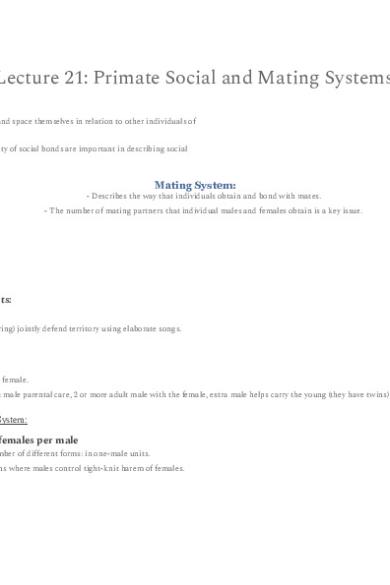21. Primate Social and Mating Systems PDF

| Title | 21. Primate Social and Mating Systems |
|---|---|
| Course | Psychobiology |
| Institution | University of Sussex |
| Pages | 5 |
| File Size | 112.8 KB |
| File Type | |
| Total Downloads | 673 |
| Total Views | 822 |
Summary
Lecture 21: Primate Social and Mating Systems:Social Organisation: How animals interact with and space themselves in relation to other individuals of the same species. Quality as well as the quantity of social bonds are important in describing social organisation. Mating System: Describes the way th...
Description
Lecture 21: Primate Social and Mating Systems: Social Organisation: - How animals interact with and space themselves in relation to other individuals of the same species. - Quality as well as the quantity of social bonds are important in describing social organisation.
Mating System: - Describes the way that individuals obtain and bond with mates. - The number of mating partners that individual males and females obtain is a key issue.
Solidarity: - Sexes live apart. - Come together for mating. - E.g. orangutans.
Monogamous Family Units: - Long term pair bond. - Male and female (with offspring) jointly defend territory using elaborate songs. - E.g. gibbons.
Polyandry (very rare): - Several males bonded to one female. - E.g. Saddle backed tamarins: male parental care, 2 or more adult male with the female, extra male helps carry the young (they have twins)
Most Common Mating System:
● Polygyny multiple females per male ○
Can occur in a number of different forms: in one-male units.
○
Hamadryas baboons where males control tight-knit harem of females.
● Polygyny within multimale-multifemale groups. ○
Males form consorts: e.g. olive and yellow baboons.
○
Mating highly promiscuous: e.g. barbary macaques.
Characteristics of Primate Social Groups: -
Complex social organisation.
-
Variety of long-term social relationships.
-
Flights are costly.
-
Dominance hierarchies.
-
Direct combat avoided using visual and vocal signals. -
E.g. use of visual signals; threat faces.
Appeasement and Reconciliation after fights achieved through: -
Grooming “grooming and gossip” Dunbar 1998.
-
Vocal Signals: NB the importance of vocalisations in facilitating social living generally
Relationship between number of vocalisation types (vocal repertoire) and social living across primate species: Evolutionary increases in vocal repertoire size among non-human primates were associated with evolutionary increases in group size and extent of social bonding.
Maternal Rank and Dominance: -
Most common for female primates to inherit the dominance rank immediately below their mother in reverse age order e.g. rhesus macaques.
-
In chimpanzees (where males stay in the natal group) dominant mothers have dominant sons.
-
Rank may be dependent on forming alliances with other individuals.
-
Alliances and male rank: -
Gorillas form alliances with relatives.
-
Chimps with relatives and nonrelatives.
Case Study: Chimpanzees: -
Opens a window on differences and similarities between humans and animals.
-
Chimps and humans share 96% of their DNA sequence.
-
Chimps are our closest relatives and we are theirs.
-
Key studies of chimpanzees, essential to have long-term studies of the behaviour of individuals.
-
Work on chimps in the Tai Forest (Ivory Coast) by Christophe Boesch and Hedwige
Boesch-Achermann. ●
Unusually complex social system
●
Fission-fusion society: requires great flexibility.
●
Live in communities (around 60 individuals in Tai Forest communities)
●
Groups members gather in unstable temporary groups (parties) that usually include only a small subset of the whole community; mixed sex.
●
Adult males form coalitions.
●
High association rates between particular adult females (friendships)
Some Background on Chimps: -
In chimps, females disperse as adolescents while males stay in natal communities throughout life (this is unusual among non-human primates where males tend to be the dispersing sex) so female friendships are between non-relatives.
-
Long lived (50yrs)
-
Large brains (large relative brain size and neocortex ratio)
-
Very fluid social organisation.
-
Hunt for meat.
-
Appear to be high level strategies in territorial behaviour and co-operative hunting -
In aggressive interactions between different communities elaborate strategies are evident – numerical assessment, silent patrols (males appear to actively search for signs or presence of neighbours by patrolling alongside or within their territories – infiltrations characterised by silent progression)
-
Sophisticated ‘collaborative’ hunts – with hunters performing complementary roles all directed towards the same prey – chasers who pursue prey pressing them forward and ambushers who go ahead, apparently anticipating escape direction and force prey back. A lot of individual variation in strategy and success rate.
Tool Making and Tool Use: -
For a long time, thought to be uniquely human.
-
When it was first described in captive chimps in the 20th century it was dismissed as an artefact.
-
Now known to be common in all studied populations of wild chimps: in tai forest chimps , more than 2 tools used per day.
-
Tool use is varied and flexible, used mainly in feeding contexts but also in social interactions and to improve personal comfort
-
Tool making is very common. -
In tai forest chimps 46% of all tools are manufactured by chimps before use; common modifications include changing length and shape.
-
E.g. nut cracking in tai chimps. -
Needs an anvil and a hard tool for hammering.
-
Nut cracking skills and other tool use is learnt.
Culture in Chimpanzees: -
Tool use occurs in all studied populations of chimps but crucially the size and nature of the tool repertoire varies between populations, as does the toolkit – this is cultural variation.
-
In cultural evolution intergenerational transmission of behaviour occurs through social learning (rather than genetically) in the biological sciences, cultural transmission is recognised as one of the two processes that can generate evolutionary change.
-
Chimps are unusual in that they show cultural variation in a range of behaviour patterns (not just a single one as is case in many animals) cultural variation evident in contexts of tool use, grooming, courtship.
-
Patterns observed have some parallels with those in human societies in which differences between cultures constituted by multiplicity of variations in technology and social customs.
Chimps and Humans are Similar in some ways: -
Complex fission-fusion social system.
-
Elaborate strategies in territorial behaviour and co-operative hunting (suggesting anticipation and planning) evidence of lethal aggression, mainly by males in intercommunity attacks.
-
Ability to fashion and use tools in unusually diverse and flexible ways. -
Evidence that chimps make and use spears and fashion missiles to fire at visitors.
-
Recent evidence of using tools to clean between teeth in the body of a chimp corpse.
-
Cultural variation in a range of behaviours.
-
High level mental abilities. -
Fieldworkers observing wild chimps observed deception, teaching and empathy; the extent to which their observations reflect a theory of mind is hotly debated and these claims must be treated cautiously.
-
Captive great apes can understand false belief.
-
Wild chimps may recognise knowledge and ignorance in others.
But different in others: -
While many of the apparent divisions between non-human primates and humans in behaviour and mind have been re-evaluated in the light of recent scientific evidence, some remain.
-
Main difference is Human language which may underpin many other differences (e.g. limited culture and technology in animals)....
Similar Free PDFs

Primate Mating Systems
- 5 Pages

Primate Evolution
- 11 Pages

Lab 3 - primate evolution
- 2 Pages

EST. Social Tema1 20-21
- 42 Pages

Hand mating - Lecture notes 1,10
- 2 Pages

Signals and Systems
- 15 Pages

Endocrine and Immune Systems
- 3 Pages

Coastal systems and landscapes
- 9 Pages
Popular Institutions
- Tinajero National High School - Annex
- Politeknik Caltex Riau
- Yokohama City University
- SGT University
- University of Al-Qadisiyah
- Divine Word College of Vigan
- Techniek College Rotterdam
- Universidade de Santiago
- Universiti Teknologi MARA Cawangan Johor Kampus Pasir Gudang
- Poltekkes Kemenkes Yogyakarta
- Baguio City National High School
- Colegio san marcos
- preparatoria uno
- Centro de Bachillerato Tecnológico Industrial y de Servicios No. 107
- Dalian Maritime University
- Quang Trung Secondary School
- Colegio Tecnológico en Informática
- Corporación Regional de Educación Superior
- Grupo CEDVA
- Dar Al Uloom University
- Centro de Estudios Preuniversitarios de la Universidad Nacional de Ingeniería
- 上智大学
- Aakash International School, Nuna Majara
- San Felipe Neri Catholic School
- Kang Chiao International School - New Taipei City
- Misamis Occidental National High School
- Institución Educativa Escuela Normal Juan Ladrilleros
- Kolehiyo ng Pantukan
- Batanes State College
- Instituto Continental
- Sekolah Menengah Kejuruan Kesehatan Kaltara (Tarakan)
- Colegio de La Inmaculada Concepcion - Cebu







